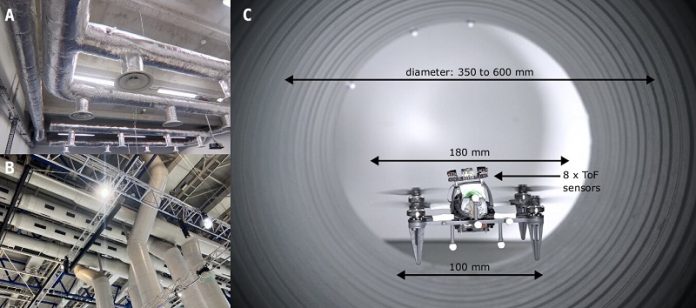
A team of researchers in France has developed a breakthrough in drone technology that could make inspecting narrow air ducts in buildings much easier and safer.
These small drones, also known as quadrotors, are designed to fly in very tight spaces—as narrow as 35 centimeters wide—making them ideal for checking areas that humans simply can’t reach.
Air ducts are essential parts of modern buildings and underground systems. They help control air quality, heating, and cooling, but inspecting them is a challenge.
Their tight spaces and delicate structure make it nearly impossible for humans to safely enter, which means important maintenance checks are often skipped or delayed.
That’s where these specially designed drones come in. They’re small enough to fit into these confined ducts and can fly both horizontally and vertically.
But flying in such tight spaces isn’t easy. As these drones move, their spinning propellers stir up air, creating turbulence that bounces back from the duct walls. This recirculated air can make the drone unstable and hard to control—especially in an environment with little room for error.
To solve this, researchers from Inria, CNRS, Université de Lorraine, and Aix-Marseille Université studied how air behaves inside the ducts when a drone is flying.
Using a robotic arm and sensors, they measured the forces in hundreds of different positions within the duct. What they found was a complex map of airflows, showing where turbulence was strongest and where it was weakest.
They discovered that certain spots inside the duct were safer for drones to fly—areas where the air forces canceled each other out, making the drone more stable. The next step was teaching the drone how to find and stay in those safe zones.
Because air ducts are dark and often lack any visual clues, traditional navigation tools like cameras or GPS don’t work. Instead, the team used tiny lasers and artificial intelligence.
They trained a neural network using motion capture data to help the drone understand its position and adjust itself to stay in the calmest part of the airflow.
This research opens up new possibilities for drone use in industries where safety and accuracy are critical. Future versions of the drone could carry cameras, thermal sensors, or gas detectors to help with everything from fire prevention to energy efficiency checks.
It’s a promising step toward safer, smarter building maintenance in places that were once out of reach.
Source: KSR.



